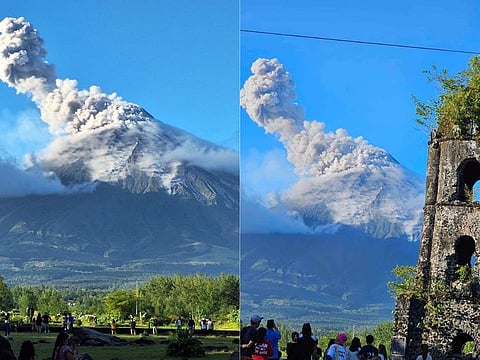Video: Booming sound, rockfall, 1.2-km plume of smoke as Mayon Volcano erupts in the Philippines
Residents witness phreatic eruption, rockfall, and plume; danger zone enforced

Mayon Volcano, one of the several active volcanoes in the Philippines, erupted on Sunday, following months of restiveness.
Manila: Residents in Albay province were shocked and awed by a booming sound as Mayon Volcano erupted at 4.37 pm on Sunday, in what volcanologists called a “phreatic eruption”.
The event was followed by rockfall, pyroclastic density currents (PDC) and a 1,200 metre-tall plume that drifted to the southwest, according to Phivolcs.
“Follow the advice of authorities,” Albay residents and visitors were urged in an emergency SMS message sent by the National Disaster Risk Reduction and Management Council (NDRRMC).
Entry into the 6-km permanent danger zone around Mayon is now prohibited as the Philippine Institute of Volcanology and Seismology (Phivolcs) have detected tectonic disturbances.
Mayon is one of the several active volcanoes in the Philippines.
There are about two dozen active volcanoes in the Philippine archipelago made up of 7,640 islands. They have had several violent eruptions in the recent past. Mt Mayon last erupted in 2018, Mt Kanlaon last erupted in 2019, while Taal last erupted in March 2022.
Alert Level 3 has been raised on Mayon by Phivolcs since June 2023 amid its restiveness which has endured for months. Over the past few months, the 2,463-metre volcano has exhibited a slow effusion of lava, moderate plume emission, and tonnes of sulfur dioxide emission, similar to eruptions in 2014 and 2018.
Residents of the Mayon Volcano's 6-km-radius permanent danger zone (PDZ) were evacuated when it started showing renewed restiveness last year.
In 2018, lava fountaining and lava flow with occasional explosions and pyroclastic density current (PDC) were recorded within the 6-km PDZ. Mayon's 2018 eruption lasted from January to March, while in 2014 eruption lasted for almost the same number of months.
Sign up for the Daily Briefing
Get the latest news and updates straight to your inbox


